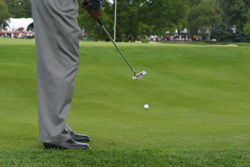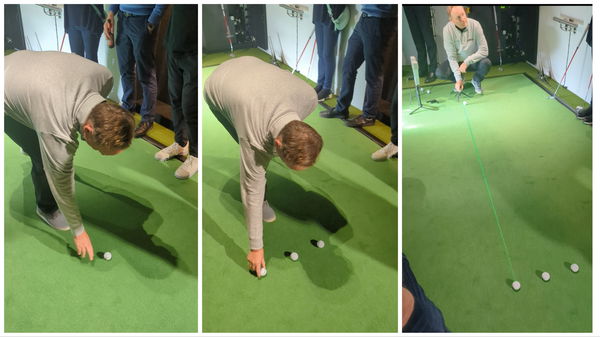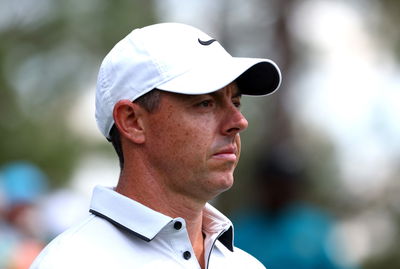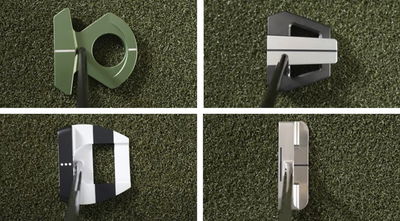Toughest Golf Shots: chip or putt off the green?
10 tips for this very common shot that tests both high and low handicappers

Found yourself just off the green? Here's our guide to chipping or putting
The chip or putt off the green shot is our first putting article in the Golf's Toughest Putts series.
It's one of the hardest shots in golf; your ball lies just short of the green but how do you know whether to chip or putt?
We've researched the subject, speaking to pros, top PGA coach Steve Blacklee of Steve Blacklee Golf Academy, and quoting from golf instruction manuals in order to put together this guide to ensure you don't get stung by this tricky shot.
There are various factors that affect your shot including the lie, the quality of fairway, or playing with or against the grass' grain. The most important aspect of the shot to consider is whether you're confident with an iron or a putter as both allow you a chance of walking away with par.
Checking the grain is vital. If the grass is angled towards the hole, using a putter is the safest option, but against the grain you need to avoid the grass using a wedge.
The bump and run shot uses the putting stroke with an iron of your choice and we suggest just practising with three even or odd numbered clubs from your bag. (9-7-5 or PW-8-6).
THE CHIP SHOT (BUMP AND RUN)
1. Align clubface to target and steepen angle of shaft
It may sound simple but aligning your clubface perpendicular to the target is vital. Once you're happy, set the shaft upright and stand the club on it's toe end.
Bringing up the heel will reduce drag on the downswing, preventing the club decelerating through the ball. The upright shaft helps with a one-level motion swing, where no wrists are used.
2. Move handle forward and distribute weight on front foot
Moving your handle forward will de-loft the club- putting overspin on the ball at contact. Then align the club handle with the midsection of your body.
Steve Blacklee says: "The weight should favour the left leg 60:40 by raising the right side up and therefore increasing the weight on the left side by tilting the upper body more over the left leg and creating a more vertical spine angle and level shoulders."
3. Use a putting stroke
The bump and run stroke is very similar to a putting stroke, it should be controlled by a rocking of the shoulders with very little wrist hinge on the backswing and keeping the hands ahead of the club head on the through swing.
Nick Faldo said: "Some guys just like doing it because they get their hands up high and just use a putting stroke, removing any other mechanics from the stroke."
4. Keep the backswing and follow-through the same
You will know if you've connected properly with the ball as the folllow-through will be the same distance from the original ball position as your backswing.
Maintain an even tempo and keep your head still. As a general rule of flight Steve Blacklee says: "As a rough guide, a 7 iron will fly 1/3 and roll 2/3rds on the green."
5. Keep hands moving towards target after impact
Point the clubhead towards the pin during your follow-through keeping your hands firm and moving forward during the swing with a smooth tempo.
Jack Nicklaus wrote in his My Golden Lessons book: "My tempo is right on the nose when the clubhead and my hands maintain a consistent relationship throughout the action - or, to put it another way, when the shaft never 'bends'".
USING YOUR PUTTER
1. Trust your instinct with the line
A common mistake amateur golfers make is being indecisive on their line ignoring their instincts and simply taking too long over the shot, so pick a spot on the green and don't look back.
This will help you forget about being off the green, but remember as Steve Blacklee says: "Sometimes when putting from a lush fringe, the ball can ‘bog’ down into the grass and never get rolling at the right speed and stop short."
2. Take normal stance
Even though you're not standing on the short stuff it doesnt mean anything needs to change with your stance. Set up how you would, keeping shoulders still and arms straight.
Referring to distance control, Jack Nicklaus said in his My Golden Lessons book: "I've found that mentally visualizing the distance in 5-foot or 10-foot increments as I stand behind the ball generally gives me the best sense of how forcefully I need to stroke."
3. Lengthen your backswing
Putting off the slightly longer fairway grass will require a longer swing so use your golfing judgement and don't be scared of giving it a good hit while maintaining your rhythm.
Steve Blacklee says: "Work the putting stroke from the back and shoulders keeping the arms passive and linked to that movement. The arms and body should work together in one coordinated move without separation."
4. Accelerate through the ball
A key reason for any part of your short game to fail is down to decelrating through the ball causing a slower impact and shortening the roll of your ball.
Remember it's still putting, you don't need to do anything fancy with your wrists, Steve Blacklee says: "Swing on a 1 – 2 tempo and let the increased momentum from a longer stroke achieve the greater distance required."
5. Keep your head down
Could there be a more simple yet vital rule in putting and short game? Keeping your head down until impact and during your follow-through will increase the chance of striking the ball exactly how you wanted. It really does work!
Steve Newell wrote in The Golf Instruction Manual that keeping your head down "ensures that your body is steady, which helps keep the putter on a true path back anbd forth; this in turn promotes a controlled, confident strike."
In this article we've worked with former David Leadbetter Director Steve Blacklee to guide us through this tricky shot. Steve is currently in charge of the Steve Blacklee Golf Academy so follow the link for more tips on improving all aspects of your game.
Want anymore tips? Check out our Golf's Toughest Putts index or the overall Golf's Toughest Shots index.











